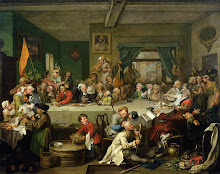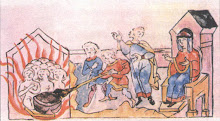"Fate that once denied him,Literary scholar Edward Pettit has for some years spearheaded a quixotic campaign to have Poe reburied in Philadelphia, as a tribute to what he sees as that city’s preeminent influence on Poe’s body of work. What is less well-known is that Pettit is merely following in the footsteps of a crusade that began only a few years after Poe’s death.
And envy that once decried him,
And malice that belied him,
Now cenotaph his fame."
-Alfred Tennyson's Poe epitaph
In July of 1856, the magazine “Cosmopolitan Art Journal” expressed disgust over the fact that the poet’s remains “rested in their burying-place, neglected by friends, and unmarked even by the plainest slab.” They suggested that Poe might be reburied in Philadelphia’s Laurel Hill Cemetery, where an appropriate monument could be raised in his honor. This is probably the earliest public call for such a statue.
In their March 1857 issue, they returned to the theme. In an editorial titled “Honor to Genius,” they lamented the “impropriety of such neglect of the man who had done so much for American Literature.” However, they were gratified to report that their earlier plea for Poe to get the posthumous respect he deserved was finding a warm response. Both the “New York Times” and Nathaniel P. Willis publicly endorsed the idea, calling for the formation of an association to attend to the matter.
Unfortunately, the remarkable personal enmity certain factions held towards Poe, even after he was no longer around to battle them, soon asserted itself. The “Art Journal” decried a recent article about Poe in the “North American Review” which “rejuvenated the grossest history of the man, and in a most cold, unfeeling manner, denied the propriety of any monument to his memory.” The “Art Journal” commented, “This expression is not strange, coming from a review for which Mr. Poe, when living, entertained a great contempt, which he betrayed upon many occasions.”
By way of contrast with this small-minded and uncharitable spirit, the “Art Journal” quoted a letter from a correspondent, which they described as representative of the many words of support their scheme had received. The unnamed letter-writer said, “Waving all opinion, and with a sense of gratitude, we would become an active worker in the matter, by soliciting subscriptions for a suitable monument to cover the mortal remains of the poet and critic, whose genius so richly endowed our Literature. Let no mockery of the cold, heartless pietest deter us from prosecuting this matter: what though we cannot worship him while living—shall we cover him with contumely when dead?”
The editorial closed with the “Art Journal” promising to “cheerfully enter” as agents in the matter, inviting the public to write to them with suggestions. “May the Grace which presides over the American Muse, bless the effort to fittingly mark the last resting-place of one of her noblest worshippers!”
Alas, the course of Poe, even more so than with True Love, never did run smooth. In June, the magazine wrote that although they had received “many communications” endorsing their idea, there was no consensus about how such an association would carry out the plan, or even who should be in charge of such a body. The “Art Journal” could merely suggest the names of General George P. Morris, Charles Scribner, and Louis A. Godey as suitable to take the matter in hand, with the hopes that these persons would respond in “a very hearty, generous way.”
The writer of this editorial was obviously well aware of the intensity of lingering prejudice against Poe. They claimed they did not intend to defend Poe against the recent “North American Review” article, (which an anonymous correspondent, who was probably James Wood Davidson, warned had had “considerable influence,”) or Rufus W. Griswold’s “heartless biography.” “We feel that the great American public looks upon these notices of the dead with aversion and disgust—that it recognizes the genius of Poe as transcendent, and will, therefore, willingly lend its material sympathy to any movement designed to perpetuate the memory of the man who has more real distinctiveness in our literature, than any other writer of his generation. There may be a propriety in dragging a man’s shortcomings before the public, when he is alive and able to defend himself: but to drag the dead from the grave, and assault the body as all of the man, is, to our mind, little else than literary cannibalism.”
The “Art Journal” quoted Dr. Joseph Snodgrass’ description of the sadly neglected condition of Poe’s current resting-place, which he considered discreditable to Baltimore in general and Poe’s relatives in particular. The magazine repeated their call for Poe to be removed to Laurel Hill, where he “may be permitted to sleep, honored and visited by those who would pay tribute to genius.”
After all this impassioned prose, the “Art Journal’s” campaign soon reached a sudden and rather depressing anticlimax. In their November 1857 issue, they carried a final notice briefly recapping their desire to give Poe honorable reburial in Philadelphia. They stated that the warm response to their call to action revealed “the great hold which the deceased poet and critic has upon American minds.”
Unfortunately, they were stopped in their tracks by the news that Poe’s family finally erected a stone over his grave, indicating that they wished their illustrious relative to stay put. “There is,” the “Art Journal” sighed, “therefore no propriety in further action, at present, and we may consider the question of the removal of the remains and the erection of a monument as withdrawn from the public,” although “we can but express regret” at how matters were taken out of the hands of Poe’s many admirers. They ended with the wistful reminder that if at any time in the future, it was decided to move Poe to Philadelphia after all, “we shall most cheerfully lend our sympathy and aid in the matter.”
Regretfully, the reports the “Art Journal” received about the belated attention given to Poe’s grave were premature. Stories about the disgracefully unkempt condition of his burial-place continued to circulate, until force of public opinion—not to mention an increasingly agitated Maria Clemm—finally spurred Neilson Poe to order a suitable headstone. However, this stone was allegedly destroyed by a runaway train, after which Cousin Neilson, who evidently felt he had already done more than his duty, washed his hands of the matter. In 1865, a Baltimore schoolteacher named Sara Sigourney Rice started a drive to give Poe’s grave proper reverence. Finally, a whole two decades after the initial monument campaign, a memorial was dedicated on November 17, 1875. It gives Poe the wrong birthday (January 20,) has no epitaph, and curious legends persist to this day that when they set out to rebury Poe under this stone, they accidentally exhumed the wrong body.
The long-gone "Cosmopolitan Art Journal" would not have been amused.
(Image of Laurel Hill Cemetery circa 1848 via Library of Congress.)

















